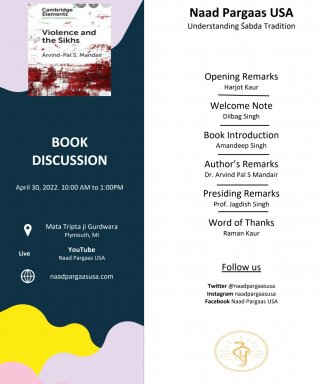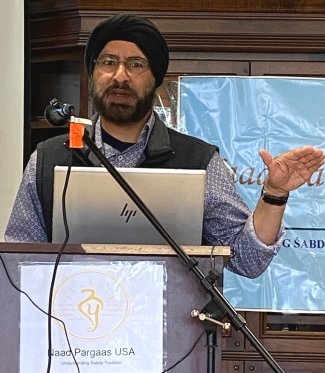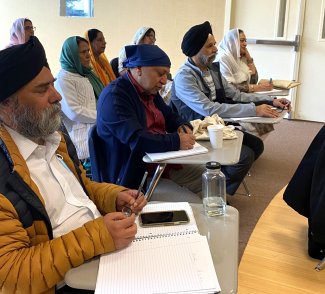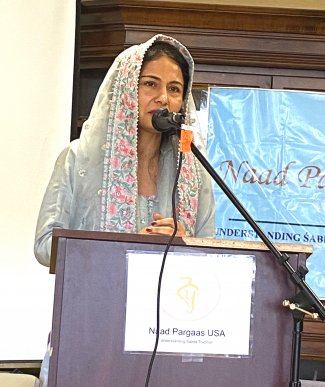Plymouth, MI April/30/2022
A book discussion on new releases Violence and the Sikhs authored by Arvind-Pal Singh Mandair, was held at Mata Triptaji, Gurdwara in Plymouth Michigan. Inaugurating the session, Harjot Kaur, Convener Naad Pargaas USA, welcomed the author, and the members of the Sangat. She said that Violence and the Sikhs, is a bold initiative that in certain ways creates opportunities for conceptual reformulations that can potentially be approached differently in (post)colonial modes of knowledge production. She mentioned that the scholarly works of the author have been instrumental in de-colonization of Sikh studies from WH McLoed’s school of understanding in academic domains.
There were two sessions to the event that was live streamed on YouTube. In the first session, the book was introduced by Amandeep Singh, Director Naad Pargaas USA. Theorizing violence, he mentioned that violence is a subject of the historical realm that is understood differently in different times and spaces. He classified violence into two parts. First, morally justifiable/ethical/rational violence that brings order in the society and therefore, violence for a higher cause. Second, irrational/egocentric/perverted violence that causes anarchy within oneself and the society. Focusing on the former type of the violence, the book, he suggested, has problematized the lens and the ethical reasoning behind the narratives that justify secular state violence as ‘rational’ and that of religion as ‘dogmatic’. Further discussing the contents of the book, he mentioned that the book categorizes temporality into Kal (historical time) and Akal (becoming of life in time) paradigms that enunciate two modes of consciousness. In Kal centric mode, human consciousness gravitates towards ego, while it gravitates away from ego in Akal centric mode. Kal centric and Akal centric violence are therefore two modes of expressing violence. Further he suggested that the framework of ‘transmission of authority’ of the Gurus should be clarified for its distinctiveness from Hegelian realization of spirit in history. For this he recommended that Sikhs scholars should try to theorize the difference between poetry and revelation so that revealed Sabda should be realized as a cosmological phenomenon and not a work of art or creativity related with anthropology of human conditions. He cautioned that in the vacuum of such understanding Sikhs would not be able to decolonize a set narrative promoted by Islamic and traditional Indian scholars that describes Gurbani as poetry of Sikh Gurus, delimiting the Prophetic experience of The Guru as ethical hero of society and history (remaining insignificant beyond history and space). This he believed was a subjective violence or sometimes a blind spot that demarcates the cosmological status of the Guru in history and sociology. He appreciated that by theorizing Violence, Dr. Mandair has taken an important step towards philosophizing critical theory and that would potentially be very fruitful for academic discourse in Sikh studies. He mentioned that there are many original concepts that the book has brought forward and that shall remain a significant source of reference in Sikh studies.
This lecture was followed by Arvind-Pal S Mandair’s (author) remarks. Shining some light on the background of what motivated him to write this book, he talked about the challenging experiences he had to encounter during his stay in England following the events of 1984. He discussed the role of media and state agencies that painted Sikh image with the brush of extremism. He also cautioned that Sikhs should make prudent choices while relating with the narrative of being a ‘martial race’. This he warned has failed Sikhs in the past deterring them to look behind the veil as political narratives continue to deceive Sikhs making them pawns of state’s subjects. Commenting on the book he explained that the framing of Violence was a liberal secular notion which despite being ‘liberal’ is actually ‘orthodoxic’ beneath its surface appearance. This framing, he described, authorized the state to unilaterally decide the nature, justification, and the idea of Violence as its sovereign dominion to legitimate and authorize violence to its own advantage. He further clarified that the Kal and Akal are not oppositional modes of experiencing time but are actually intertwined with each other. The consciousness of Gurmukh remains in a state of tension with ego and the violence is therefore an internal experience of mind’s fight with ego that externalizes to perform Sovereign violence. Towards the close of his talk Dr. Mandair mentioned about struggles and oppositions he received for publishing the theoretical framework of Violence. This he mentioned was because the Sikh experience of violence has been hegemonized into a secular narrative and that such usurping needs to be resisted with scholarly efforts.
The second half of the event started with a Q and A session from the author. The Sangat members asked some interesting questions to the author that Dr. Mandair explicitly answered to their satisfaction.
Prof Jagdish Singh presented his presiding remarks towards the end of this session. He pointed towards different dimensions in which the work of Dr Mandair has rolled out. While congratulating the author, he unveiled the magnitude of depth in which the book was authored. He further suggested that violence occurs primarily in lower experiences of time where ‘otherization’ is historically enunciable. However, in higher dimensions the Guru bestows His grace on dark dimensions of life as much as the brighter ones. Using the example of Guru Nanak’s Sakhi during his encounter with Babur, he mentioned that the two stones of the flower mill that rotate in Babur’s prison are symbolically related with the paradoxical dual aspects of human experience in time that Prof. termed as anubhavi dupakhta.
He mentioned that the dual aspects of human experience remain in connection with Mauldi Nischitta (Blossoming Certainty) or the cosmological Hukum. In this eternal realm of time and consciousness, violence is displaced by meta-metaphysics. He mentioned that the book has helped to intuitively decode that in the absence of such experiencing, the idea of violence gets modulated and conditioned within historical tensions. This, he mentioned, was a unique contribution of the author to undertake philosophical engagements in Sikh idiom that was laid down through a rigorous academic discourse. He recognized that the conceptual references driven from Sikh doctrines was an important step that should potentially open spaces in Western academia towards Sikh studies.
In the end Dr Mandair appreciated the works of Naad Pargaas USA for conducting the event and expressed his satisfaction that the organization was making attempts to engage rigorously in academic discourses. He was pleased that the medium of communication was in two languages during the seminar and that was a significant step towards confluence of two ways of understanding and experiencing, which he believed was potentially very fertile in further development of Sikh Studies.
The session was concluded by word of thanks from Harjot Kaur. She mentioned that Naad Pargaas USA shall continue to engage in academic exercises for which there was a need for developing a research center that could foster research activities with world class facilities including a state-of-the-art library, inviting students and scholars to study, deliver lectures, conduct seminars, and conferences in the domain of Sikh studies.






